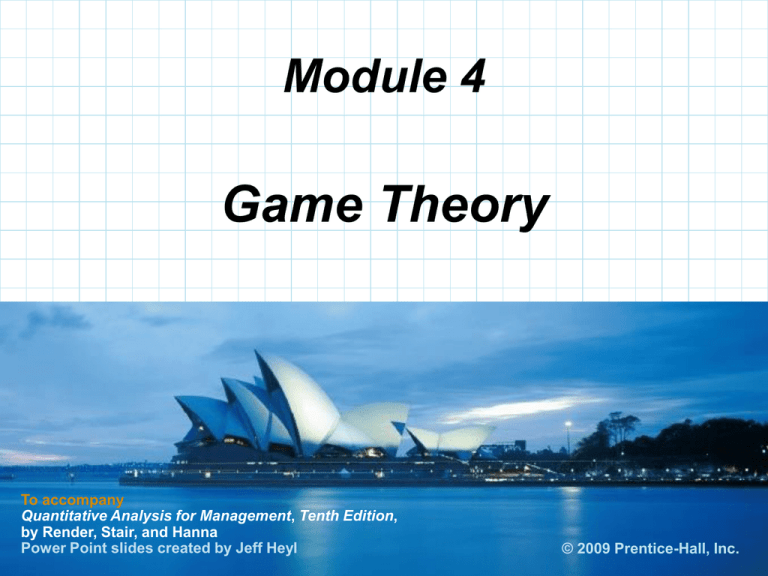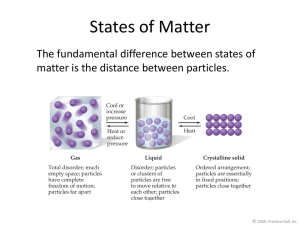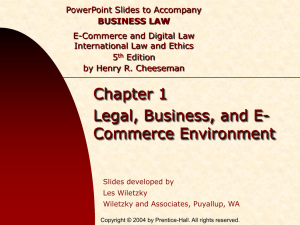Mixed Strategy Games
advertisement

Module 4 Game Theory To accompany Quantitative Analysis for Management, Tenth Edition, by Render, Stair, and Hanna Power Point slides created by Jeff Heyl © 2008 Prentice-Hall, Inc. © 2009 Prentice-Hall, Inc. Learning Objectives After completing this chapter, students will be able to: Understand the principles of zero-sum, two- person games. Analyze pure strategy games and use dominance to reduce the size of a game. Solve mixed strategy games when there is no saddle point. © 2009 Prentice-Hall, Inc. 17 – 2 Module Outline M4.1 M4.2 M4.3 M4.4 M4.5 M4.6 Introduction Language of Games The Minimax Criterion Pure Strategy Games Mixed Strategy Games Dominance © 2009 Prentice-Hall, Inc. 17 – 3 Introduction As discussed in Chapter 1, competition can be an important decision-making factor. Game theory is one way to consider the impact of the strategies of others on our strategies and outcomes. The study of game theory dates back to 1944, when John von Neumann and Oscar Morgenstern published their classic book, Theory of Games and Economic Behavior. Game theory continues to be important today. Game models are classified by the number of players, the sum of all payoffs, and the number of strategies employed. © 2009 Prentice-Hall, Inc. 17 – 4 Language of Games To introduce the notation used in game theory, let us consider a simple game. Suppose there are only two lighting fixture stores, X and Y, in Urbana, Illinois. (This is called a duopoly.) The respective market shares have been stable up until now, but the situation may change … The 2 x 2 payoff matrix in Table M4. 1 shows what will happen to current market shares if both stores begin advertising … © 2009 Prentice-Hall, Inc. 17 – 5 Payoff Matrix (Table M4.1) Store X’s Payoff Matrix Y1 (Use radio) Y2 (Use newspaper) X1 (Use radio) 3 5 X2 (Use newspaper) 1 -2 Table M4.1 © 2009 Prentice-Hall, Inc. 17 – 6 Language of Games (cont.) A positive number in Table M4.1 means that X wins and Y loses. A negative number means that Y wins and X loses. The game in Table M4. 1 is biased against Y. Player Y would use the minimax criterion. © 2009 Prentice-Hall, Inc. 17 – 7 Language of Games (cont.) Game Outcomes X1 (use radio) Y1 (use radio) X wins 3 and Y loses 3 X1 (use radio) Y2 (use newspaper) X wins 5 and Y loses 5 X2 (use newspaper) Y1 (use radio) X wins I and Y loses I X2 (use newspaper) Y2 (use newspaper) X loses 2 and Y wins 2 © 2009 Prentice-Hall, Inc. 17 – 8 The Minimax Criterion A player using the minimax criterion will select the strategy that minimizes the maximum possible loss. The upper value of the game is equal to the minimum of the maximum values in the columns. The lower value of the game is equal to the maximum of the minimum values in the rows. If the upper and lower values of a game are the same, this number is called the value of the game, and an equilibrium or saddle point condition exists © 2009 Prentice-Hall, Inc. 17 – 9 The Minimax Criterion (cont.) For the game presented in Table M4.2, the value of the game is 3, because this is the value for both the upper and lower values. The value of the game is the average or expected game outcome if the game is played an infinite number of times. An equilibrium or saddle point condition exists if the upper value of the game is equal to the lower value of the game. © 2009 Prentice-Hall, Inc. 17 – 10 Minimax Solution Table M4.2 X1 SADDLE POINT Y1 Y2 Minimum 3 5 3 X2 1 -2 Maximum 3 5 -2 Maximum of minimums Minimum of maximums © 2009 Prentice-Hall, Inc. 17 – 11 Pure Strategy Games A pure strategy exists when ever a saddle point is present. Using minimax criterion, we saw that the game in Table M4.2 had a saddle point and thus is an example of a pure strategy game. Another example of a pure strategy game is shown in Table M4.3. Notice that the value 6 is the lowest number in its row and the highest number in its column. Thus, it is a saddle point and indicates that strategy X1 will be selected by player X and strategy Y2 will be selected by player Y. The value of this game is 6. © 2009 Prentice-Hall, Inc. 17 – 12 Example of a Pure Strategy Table M4.3 Minimum row number Maximun column number Y1 Y2 X1 10 6 6 X2 -12 2 -12 10 6 © 2009 Prentice-Hall, Inc. 17 – 13 Mixed Strategy Games When there is no saddle point, players will play each strategy for a certain percentage of the time. This is called a mixed strategy game. In a mixed strategy game, each player should optimize the expected gain. Consider the game shown in Table M4.4. There is no saddle point, so this will be a mixed strategy game. © 2009 Prentice-Hall, Inc. 17 – 14 Game Table for Mixed Strategy Game Table M4.4 Y1 Y2 X1 4 2 X2 1 10 We must weight the payoffs by the percentages of the times to play each strategy to compute the expected gain for each of the different strategies that player X may choose. © 2009 Prentice-Hall, Inc. 17 – 15 Game Table for Mixed Strategy Game with Percentages (P, Q) Shown Table M4.5 Y1 Y2 P 1–P Expected Gain X1 Q 4 2 4P+2(1-P) X2 1-Q 1 10 1P+10(1-P) 4Q+1(1-Q) 2Q+10(1-Q) Expected Gain © 2009 Prentice-Hall, Inc. 17 – 16 Mixed Strategy Games (cont) Solving this for Y, after we set the expected values for Y and X equal, we have: P = 8/11 and 1 - P = 1 – 8/11 = 3/11 Thus, 8/11 and 3/11 indicate how often player Y will choose strategies Y1 and Y2 respectively. The expected value computed with these percentages is 1P + 10(1 - P) = 1(8/11) + 10(3/11) = 38/11 = 3.46 © 2009 Prentice-Hall, Inc. 17 – 17 Mixed Strategy Games (cont) Performing a similar analysis for player X, we let Q be the percentage of the time that strategy X1 is played and 1 — Q be the percentage of the time that strategy X2 is played. Using these, we compute the expected gain shown in Table M4.5. © 2009 Prentice-Hall, Inc. 17 – 18 Mixed Strategy Games (cont) We set these equal, as follows: 4Q + 1(1 - Q) = 2Q + 10(1 - Q) Solving for Q we get Q = 9/11 and 1 - Q = 2/11 Thus, 9/11 and 2/11 indicate how often player X will choose strategies X1 and X2 respectively. The expected gains with these probabilities will also be 38/11 or 3.46. © 2009 Prentice-Hall, Inc. 17 – 19 Dominace The principle of dominance can be used to reduce the size of games by eliminating strategies that would never be played. Using the principle of dominance, we reduce the size of the following game: Y1 Y2 X1 4 3 X2 2 20 X3 1 1 © 2009 Prentice-Hall, Inc. 17 – 20 Dominace (cont) In this game, X3 will never be played because X can always do better by playing X1 or X. The new game is Y1 Y2 X1 4 3 X2 2 20 © 2009 Prentice-Hall, Inc. 17 – 21 Dominace (cont) Here is another example: Y1 Y2 Y3 Y4 X1 -5 4 6 -3 X2 -2 6 2 -20 © 2009 Prentice-Hall, Inc. 17 – 22 Dominace (cont) In this game, Y would never play Y2 and Y3 because Y could always do better playing Y1 or Y4. The new game is : Y1 Y4 X1 -5 -3 X2 -2 -20 © 2009 Prentice-Hall, Inc. 17 – 23 Module 4 - Game Theory fin Quantitative Analysis for Management, Tenth Edition, by Render, Stair, and Hanna © 2009 Prentice-Hall, Inc. 17 – 24











